
Right brain kinesthetic learners face huge risks this school year. Many teachers will be new, schools may be understaffed, and special educators may be overwhelmed. In this blog, we will discuss:
– How to expedite a special education evaluation
– Why and how to improve an IEP
– Why more may be necessary to have your child reach his or her potential.
Note, many public and charter schools have invested in dyslexia treatments. This will help student’s reading fluency, but it often does not significantly improve reading comprehension.
We have had parents who asked their child’s school to evaluate their child for special education services. We have heard many excuses, with the most common being, we need to complete the RTI or Response to Intervention Process first — some schools now refer to this as MTSS, or Multi-tiered System of Support.
This is not acceptable. Back in 2011, Dr. Melody Musgrove, the Federal Director of the Office of Special Education Programs, developed a policy that “RTI Cannot Be Used to Delay or Deny an Evaluation”. Click on this link and you will get a more in-depth discussion of this issue, a copy of Dr. Musgrove’s letter. RTI Cannot Be Used to Delay or Deny an Evaluation “. Here is a link to a sample letter you can tailor to your situation. We have used this hundreds of times and it works virtually every time. Mary used this note and made sure to give her informed consent for an evaluation. It was approved 1 week later, the evaluation was completed, and an IEP was developed within 60 days. It is doable.
Most Individualized Education Plans or IEPs we read anger us. There has been a trend to focus on reading fluency, how well a student reads out loud, and even when there are reading comprehension goals, they rarely close the gap.
Let’s take the case of Alex. He was a 6th grader. His IEP said he was reading at the 5th grade level. His homework, which should have been taking an hour, was now taking 3 hours and sometimes more.
When we assessed his reading comprehension, we found his reading comprehension was at the 3rd grade level. For comprehension, his goal was to answer who, what, where, why and how questions correctly 4 out of 5 times at his independent reading level.
Mom asked for an interim IEP meeting and asked the school to evaluate his reading fluency and his reading comprehension. The school assessment showed his reading fluency and reading comprehension were at the 5th and 3rd grade levels respectively. Mom got an interim IEP and they adjusted his reading comprehension goal to make 1.5 grade level improvement in a year.
For The Right Brain Kinesthetic Learner, Schools Rarely Address 5 Key Issues
While reading fluency has gotten a great deal of attention with the focus on dyslexia, 3 issues that are often not addressed in a comprehensive way include:
- Reading comprehension. Note, if a student is 3 years below grade level and over the next year they improve their reading comprehension 1.5 grade levels, they will still be 2.5 years below grade level.
- Vocabulary. The right brain kinesthetic learner often does not master vocabulary the way schools teach. Looking up the definition, writing the word and using flash cards to master the words rarely helps the right brain kinesthetic learner.
- Executive function issues are often identified but not addressed. We have seen students who have IEPs for years where.
- Attention continues to be a major issue
- They have an excellent visual memory, but have great difficulty remembering what they hear or read
- They read very slowly
- Visual processing issues often get worse as the words get smaller. This may result in skipping words and lines when reading, making careless mistakes in math and having difficulty copying off the board.
- Too often the right brain kinesthetic learners are both frustrated and anxious.
At 3D Learner, our goals often include:
- Targeted efforts to improve reading fluency, based on the specific needs of a student.
- Improving reading comprehension by 2, 3 and even 4 grade levels within 4 to 6 months.
- Significantly improving vocabulary, first with a focus on the small words that often confuse a right brain kinesthetic learner.
- Identifying and addressing the relevant executive function and/or visual processing issues.
- Lowering anxiety and frustration, while boosting self-confidence.
If we can help in any way, call us at 561-361-7495 or click here to schedule a conversation.

For the bright right brain kinesthetic learner, math word problems have become a major issue. While reading scores dropped after the pandemic, math scores dropped even further. As shown below, the percent of 4th and 8th graders meeting grade level standards on the NAEP (National Assessment of Educational Progress), dropped by 7 and 8 points respectively. The bad news is that problems with math word problems rarely self-correct.
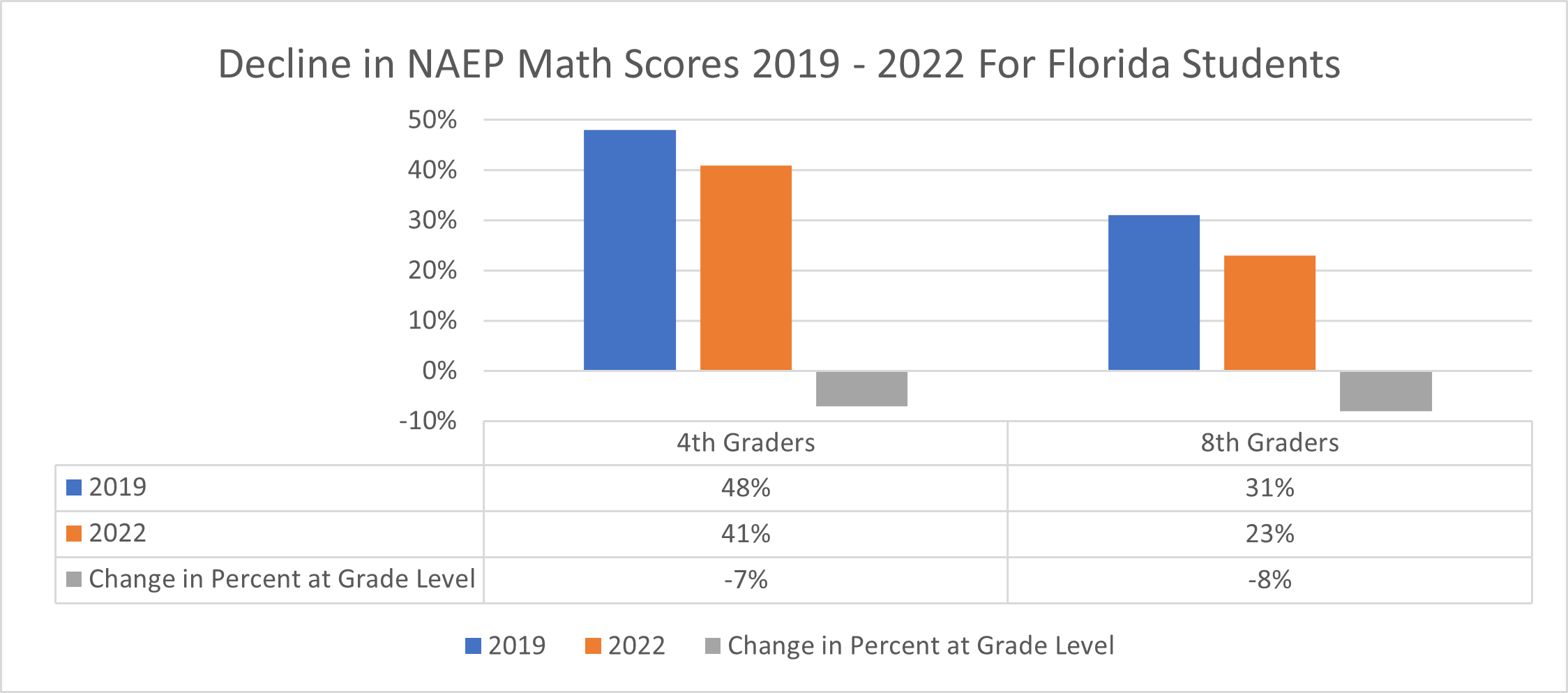
The good news is that we have over 25 years of experience helping students to make dramatic gains in their math performance. This includes:
- A student who had been to 17 other math tutors and was operating at the1st percentile in math. We were able to get her to the 47th percentile
- A smart 4th grader, who we were able to get from the 48th to the 98th percentile
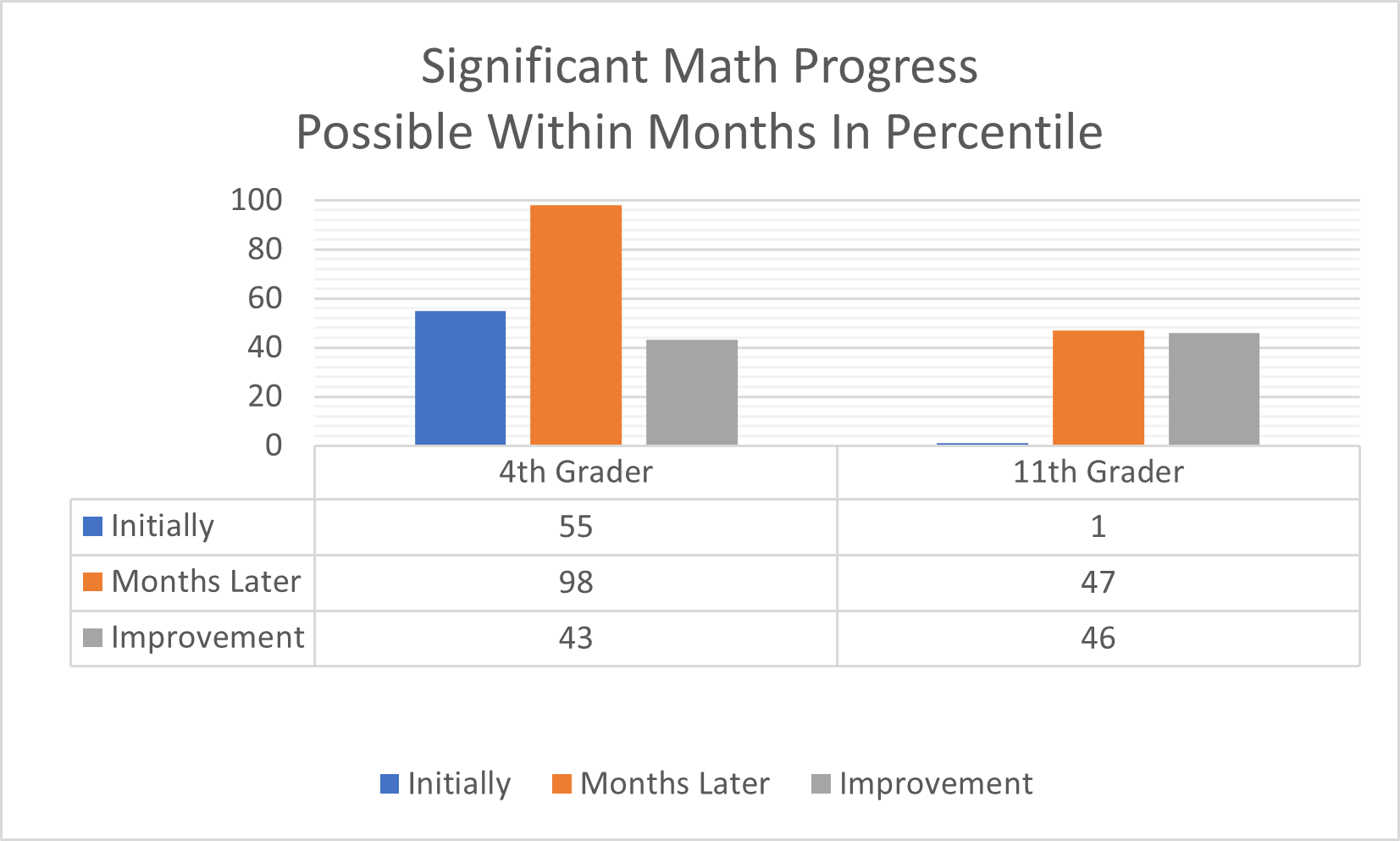
- Many students who were getting Cs, Ds and Fs, who went to As and Bs within months
If your child is experiencing difficulties with math word problems and you want to discuss what can be done,
Call us at 561-361-7495 or
Click here to schedule a Math Stress to Success Conversation
The Bright Right Brain Kinesthetic Learner may do well in the lower grades in math, but …
When math shifts in third and fourth grades to math word problems, virtually all our students have problems. This is often the result of many challenges, including:
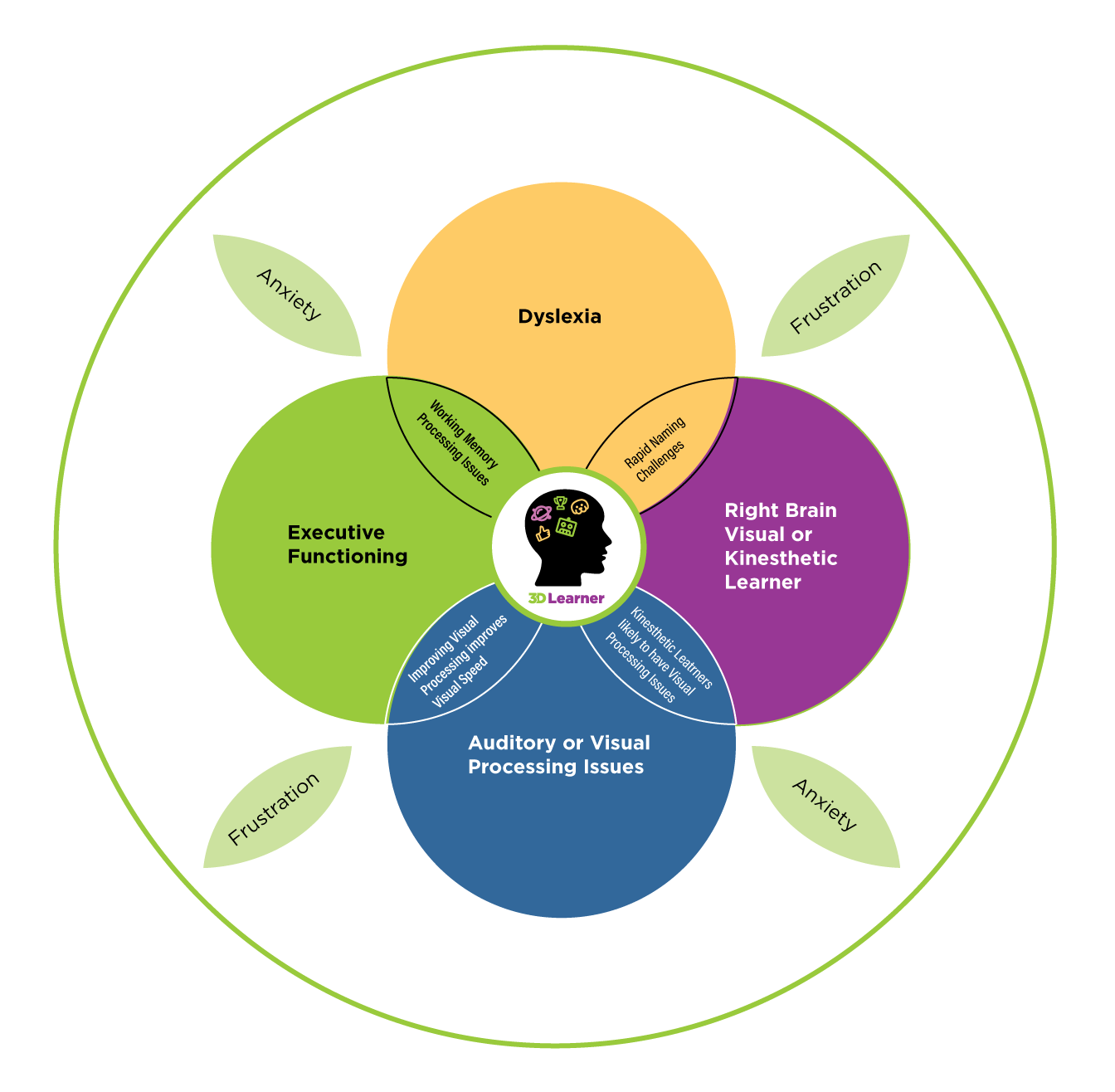
Learning differences, visual processing issues and/or executive function issues are the multiple challenges that make math problems so difficult, and why remediation must address the relevant issues.
- The bright right brain kinesthetic learner learns differently than the logical, sequential and auditory approach that schools may use. They often have problems recognizing words, with the vocabulary and with the way the problems are worded. The right brain kinesthetic learner often does not learn how to leverage their visualization skills to understand and solve the problems.
- Visual processing issues are both common with the right brain kinesthetic learner and visual processing issues result in:
-
- Number reversals
- Not lining up the numbers correctly
- Missing signs – especially negative and division signs
- Making careless mistakes
- Executive function challenges may cause:
- Problems remembering math facts and the order of operation
- Losing focus when doing homework, during class when they are lost and during tests
- Difficulty finishing tests on time — the right brain kinesthetic learner
- Anxiety and frustration with math. We have heard too many students in the last year say, “I hate Math”.
For Bright Right Brain Kinesthetic Learners Struggling with Math Word Problems:
We Assess for Success looking
- How your child learns best
- Whether he or she has a visual processing issue
- Whether there is an attention, working memory and/or processing speed issues
We offer an Integrated, Engaging and Effective Program that often results in significant gains within months, especially for the bright right brain kinesthetic learner.
If your child is experiencing difficulties with math word problems and you want to discuss what can be done,
Call us at 561-361-7495 or
Click here to schedule a Math Stress to Success Conversation

Parenting a bright right brain kinesthetic learner has been made more challenging as the request for private school slots exceeds availability. With a new Florida Law likely to provide private school vouchers for many more students, we expect private school demand to accelerate for the 2023-24 school year and beyond.
In this blog post, we will cover 3 scenarios where parenting a bright right brain kinesthetic learner has gotten harder, why it will get worse and what parents can do about it.
Given the very competitive nature of private schools, as a parent, you may find yourself wanting some help. We are only a phone call away. We have helped many parents navigate through some tough challenges, and best of all, we have helped many students do far better in private schools than others thought possible.
Consider how much different your child’s live would be when:
- Your child is doing far better in school.
- Your child’s self-esteem is much higher, and their anxiety is much lower.
- Their reading comprehension is 2 years better than it is now.
- Math is now a strength and math homework takes much less time and is done right.
- They are performing much better in a non-academic effort – karate, sports, music etc.
- Your anxiety and frustration is much lower.
For a no cost Private School Conversation, either:
– Call us at 561-361-7495
– Click here to schedule a Conversation
What is a Bright Right Brain Kinesthetic Learner
It’s important that we understand that we all have different strengths and areas that need strengthening. We DO learn differently, and although we need to learn using all modalities, when a child is struggling, it is important that learning is targeting a child’s strengths. A student who learns best when he or she sees and experiences information is how we characterize a BRIGHT Right BRAIN KINESTHETIC LEARNER. They often learn best when they can discover patterns and do far better with experiential learning that combines visual, kinesthetic and engaging strategies.
These students often struggle with:
- Reading comprehension and math, especially word problems
- Executive function issues (e.g., working memory, processing speed and attention)
- Auditory or Visual processing issues

These bright right brain kinesthetic learners face several challenges that make private schools challenging:
- They are often a lot smarter than their reading comprehension or math skills would indicate.
- Private schools often rely on entrance exams that are difficult for these students to pass-they are very “wordy”!
- Private school curriculums are often a year ahead of the public school’s curriculum. For a student who is a year or two below grade level, this puts them two or three years below what is expected.
- Many private schools are now offering expensive tutoring that schools may require, but they may not be what your child needs. Understanding HOW your child learns, is vital.
With Help, Many Bright Right Brain Kinesthetic Learners Can Succeed
Michael’s parents were furious. Despite a 132 IQ, the psychologist had recommended her son not go to a rigorous private school. He recommended another year of phonics-based training and that the parents enroll Michael in a school for students with learning disabilities and dyslexia. Looking at the two dyslexia treatments that were recommended, mom asked the psychologist, “Is there a third option that teaches the way my son learns?”.
He referred them to 3D Learner. Mom called us from the psychologist’s parking lot.
The first three questions piqued mom’s interests:
- Does your child remember places visited, even from years ago?
- Does your child learn best when he sees and experiences information?
- Is your child a lot smarter than present results would indicate?
It turns out Michael was a bright right brain kinesthetic learner with working memory and processing speed issues. We were able to significantly improve his reading comprehension, executive function skills and his confidence. Note, many right brain kinesthetic learners have excellent memories for what they see and experience, but not for what they read or hear. They are processing a great deal of information, but their visual processing issues often slows down their reading.
Michael did much better from day one, and he got into the rigorous private school and even better …
The young man graduated high school near the top of his class and later graduated from MIT.
⇒ All because mom decided to pursue a strength-based option for learning.
Her comment was, “You changed his attitude about himself and that was 90 percent of the battle”. KF Parkland, FL
For a no cost Private School Conversation, either:
– Call us at 561-361-7495
– Click here to schedule a Conversation
The Bright Right Brain Kinesthetic Learner Struggling to Keep Up
Sarah was struggling to keep up. The school recommended grade retention. When the parents rejected that, tutoring was recommended. Again, not consistent with what this bright right brain kinesthetic learner needed. Mom called a friend and described her challenge. The friend said, “I cannot help you, but I think Denise can”. Mom then called Denise and after an hour, they realized that both had smart kids who learned differently. Mom called and they came for the 3D Learner Program ®. Sarah was initially the lowest reader in her class and she avoided reading. By the next school year, she was at the top of her class in reading comprehension and the most avid reader. In a month-long competition, the average student read 180 pages, her best friend read 360 pages; Sarah read 720 pages. When asked why she now loved reading, Sarah said, “3D Learner taught me how to create videos and visuals for what I read, do you know how cool that is?”
The parents commented, “You showed us our daughter’s gifts, and helped transform her into an outrageously successful student” Mr and Mrs R, Florida
For a no cost Private School Conversation, either:
– Call us at 561-361-7495
– Click here to schedule a Conversation
⇒ All because a mom and dad chose to take the path less traveled.
The Student Who Is Doing OK, Can Often Excel, and Parents Are Not Aware Their Child is a Bright Right Brain Kinesthetic Learner
Parents are often baffled by the challenges their child faces. Many parents of bright right brain kinesthetic learners are not aware of their child’s strengths. Mary was visiting a friend, whose dyslexic son had been struggling in school. Mary and her friend were sitting in the kitchen when the young man walked into the living room with a book and devoured it. Mary asked, “What happened? Jake never read like that before.
Mom indicated they had come to us. Mary asked, “Does 3D Learner help kids who do not have dyslexia, are doing OK, but have the potential to do far better?” Her friend answered, “Yes, they do”. They help students who are creative and learn differently. Give them a call.”
Mary did and her daughter blossomed after our training. She went from a C- student to an A student and her confidence soared.
For a no cost Private School Conversation, either:
– Call us at 561-361-7495
– Click here to schedule a Conversation
Some Private Schools Are Not Right for Certain Right Brain Kinesthetic Learners
We have had cases where a school was not the right fit for a child. This is especially true when the school caters to the very bright and often gifted, high achieving students, and the student in question has a below average IQ.
Nancy had a case like this with her third child Max. Her other two children were well suited to this highly competitive school, but Max was not. In this case, we worked with the parents to find the right school. Since there was no room for the balance of the school year at the new school, we worked out a win-win situation where Max could stay at his present school, and we would supplement his education.
Bright Right Brain Kinesthetic Learners Can Often Excel, with the Right Help
If your child is facing challenges with a private school, consider four things:
- Is your child a lot smarter than present results would indicate?
- Might your child be a bright right brain kinesthetic learner, who would benefit from a different approach?
- Would you like to know how your child can make significant gains in months
- Would you like help from a Parenting Guide, who specializes in helping Parents to Navigate the Private School Puzzle.
Note, while the majority of our students are bright right brain kinesthetic learners, we also help students with executive function and related challenges
For a no cost Private School Conversation, either:
– Call us at 561-361-7495
– Click here to schedule a Conversation
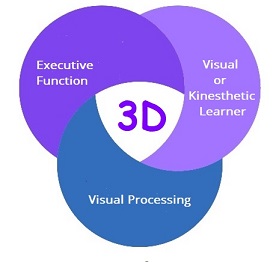
Many smart struggling students are either a Kinesthetic Learner, have Executive Function challenges and/or have a Visual Processing issue.

Is your child a visual or kinesthetic learner with executive function &/or a visual processing challenge?
Our comprehensive assessment process is designed to tailor a solution to meet your needs
Three key differences to take note of in 2022 – 23 school year:
- Reading comprehension and math gaps are wider than in prior years. Math is now the most common issue. Math word problems are often a huge problem for an older kinesthetic learner.
- Executive function and visual processing issues are even more common and more severe
- Anxiety and frustration are much bigger issues
7 Ways The 3D Learner Assessment is different than most:
1- Our end goal is to tailor a program to help your child succeed.
2- We identify your child strengths and how to use them in creating a program
3- We identify the key executive function issues that often hold a student back. These may include attention, working memory, processing speed, etc.)
4- We assess for a visual processing issue. For local clients, we use a Visagraph ® that shows you exactly how your child’s eyes track when reading
5- We assess for your child’s present level of reading comprehension, and we assess their writing skills
6- We identify key learning strengths and challenges. The strengths often boost a student’s self-esteem and show potential. The challenges show us where improvement is needed.
7- We tailor a program to meet your child’s needs and your goals.
We also recognize that anxiety is a major issue and …
3D Learner is now offering the Safe and Sound Protocol ® at no cost
for those investing in a Comprehensive Assessment by September 30th
Call 561-361-7495 or click here to book an Assess for Success conversation
Note, the 3D Learner assessments can be done remotely via zoom or at our Coral Springs office. The only difference is we cannot do the Visagraph ®, that shows visual tracking, and the Interactive Metronome ®, that assesses for attention challenges, remotely,
As a transformational learning center, we use the assessment process to tailor solutions to meet our students’ needs. Most parents are frustrated that their child struggles with 3, 4, 5, 6 or all 7 of the following challenges:
- They are a lot smarter than their present level of reading comprehension would indicate
- Math may be an issue, but math word problems are almost always an issue
- Putting their thoughts on paper and/or handwriting Their child may be able to hyperfocus on video games, Legos or science, but their child often has difficulty paying attention to that which is boring. A fraction of our students have ADHD, Attention Deficit and Hyperactivity Disorder), others have an attention issue, and others do not
- Spelling, remembering math facts and remembering simple auditory instructions is a challenge. This is often called working memory
- Their child reads and may respond slower than one would expect — processing speed. People do not realize this is often caused by a visual processing challenge
- Anxiety and frustration are all too common
Why We Assess for How Your Child Learns Best,
Executive Function, Visual Processing and other Challenges
Most smart struggling students learn best when they see and experience information. We call this student a kinesthetic learner. Others may call them a right brain or visual learner. These students often struggle more than their more logical, sequential and auditory peers with remembering words seen and not mastered, not understanding high frequency words and with visual processing issues. That is, they often have better peripheral vision, but they often skip words and lines when reading.
They also do far better with reading comprehension and with math with kinesthetic learning. They find the work more engaging, it leverages their visual memory, and we make it more relevant.
Our comprehensive assessment includes:
– The Structure of Intellect Assessment ® that identifies:
– How your child learns best
– Your child’s strengths and challenges
– Whether there appears to be a visual or auditory processing issues
One principal at a school in Boca Raton asked her special education specialist during an IEP meeting, why they stopped using this assessment. The ESE specialist said the assessment was great because it identified how a child learned best and their strengths and challenges. She then added that the Federal Government requires public schools to focus on a label,(in order to get program funding) and the SOI does not do that. She then added, that 3D Learner has the luxury of using this assessment because they are primarily interested in tailoring a program to help a student succeed
The Mindprint Assessment(R) that assesses Executive Function and identifies strengths and weaknesses for:
- Working Memory
- Processing Speed
- Attention
- Flexible Thinking
- Abstract Reasoning
- Spatial Perception
- Verbal Reasoning
- Verbal Memory
The MindPrint cognitive screener was developed by neuroscientists at University of Pennsylvania’s Perelman School of Medicine through a National Institutes of Health grant. This online assessment is so reliable and efficient NASA uses it to test the astronauts during long-duration space flights. It is an excellent assessment, and where help is needed, we can provide it with the Brainware Safari Program ®, the Interactive Metronome ® and the core 3D Learner Program ®
For local clients, we use a Visagraph that shows how a student’s eyes track when reading. Click here to see how a student’s eyes tracked before and after our program.
We use the Interactive Metronome ® to assess for attention.
We do a Woodcock Johnson Reading Comprehension ® assessment.
3D Learner is now offering the Safe and Sound Protocol at no cost for those investing in a Comprehensive Assessment by September 30th
Call 561-361-7495 or click here to book an Assess for Success conversation

For Your Kinesthetic Learner with Executive Function and/or Visual Processing Issues
How to Help Your Child Succeed
(Assessment Special at the Bottom of the Page)
Most students we see are a kinesthetic learner with some executive function issues. They often have visual processing issues. Frustration and anxiety appear to be impacting these students even more than others.
This blog post is focused on how you, as a parent can:
- Stabilize the situation now. We are seeing large numbers of kinesthetic learners with frustration and anxiety issue
- Get help from your child’s teacher to do the same
- Start the investigation process to consider what else needs to be done
- Do the same process with their school
- Take control of the process and look for a program that assesses and addresses the Whole Child — with a focus on your child’s strengths and challenges.
7 Key Points About the Kinesthetic Learner with Executive Function and/or Visual Processing issues
- The kinesthetic learner learns best when he or she sees and experiences information. Too many words often overwhelm them. Keep instructions visual and use a few words — focused on what you want them to do and why
- Working memory and/or processing issues are often challenges. Checklists and visual schedules really help. Psycho-education evaluations often identify these issues.
- Visual processing is a very common challenge for the kinesthetic learner. The kinesthetic learner often has better peripheral vision and their eyes are often scanning the environment. The kinesthetic learner often skips words and lines when reading and/or has problems copying off the board.

- Anxiety and frustration are often present. As parents, we recommend you:
-
- Stay calm. Nothing reduces stress and anxiety quicker than a calm parent
- Use checklists and visual schedules
At a quiet moment, ask your child:
-
- What are you enjoying about school
- What is causing you any stress or anxiety
- How can we help
Share the relevant information with their teacher
-
- Where your child is strong
- Where they tend to struggle
- What small changes might make big differences
- Ask them if they are seeing the same thing or something different
- Ask them if they have your child’s present level of performance on reading comprehension and math and if not, when might they have it. In Florida, public schools are required to complete their first round of assessments by September 30th. They are now required to share that with parents
We have an excellent system that reduces stress and anxiety called the Safe and Sound Protocol. This is normally a $300 investment. For those parents investing in our Comprehensive Assessment for your child by September 16th, we will be including the Safe and Sound Protocol at no extra cost
To start the conversation, either call us at 561-361-7495 or
click here to schedule a Conversation on How to Help Your Child Succeed
- Use the next few weeks to initiate action where needed and to investigate the following:
-
- Schools are often slow to assess a child for a learning disability, dyslexia or some other learning problem. If you think your child needs to be assessed, we encourage you to initiate the process ASAP. . Schools will often tell a parent, “We do things sequentially. We need to initiate either RTI or MTSS (Response to Intervention or Multi-Tiered System of Supports), before we assess. The Federal Government has issued guidance that RTI Cannot Be Used to Delay or Deny an Evaluation. If this is an issue, we recommend you visit our webpage www.3dlearner.com/rti-mtss where we provide a link to the letter from the Office of Special Education Programs and a sample letter you might share with their school.
- The single most important point for the kinesthetic learner with executive function and/or visual processing issues is that neither schools nor most programs identify or address the whole child. Specifically:
-
- Schools do not often assess a child’s learning style.
- Executive function issues are often identified, but rarely addressed
- Visual processing issues are often missed and rarely addressed
- Anxiety, attention and frustration are often left to the psychologist and/or the parent, when there are natural and effective ways to address them
- Parent coaching is rarely addressed, and it can be incredibly helpful
At 3D Learner, we recognize the need for:
- An assessment that focuses on the Whole Child
- Training that teaches the way a right brain, visual or kinesthetic learner learns
- Addressing the executive function issues as part of an integrated program
- Identifying and addressing the relevant issues
- A solution that will lead to significant gains within months
- Combining a program that offers
- Immediate benefits
- Provides an Assessment for Success
- Offers a program that can be tailored to your child’s needs
- Provides you with the tools and processes to be the parent your child needs
Comprehensive Assessment Special
For those parents investing in our Comprehensive Assessment before September 16th we are offering:
Our comprehensive assessment that includes:
- The Structure of Intellect Assessment ® that identifies:
-How your child learns best
– heir strengths and challenges
-Whether there appears to be a visual processing issue
-Your child’s present level of performance
- The MindPrint Assessment ®
–An executive function assessment for students 8 and older
- For local students, in our office
-A Visagraph ® assessment that shows how your child’s eyes track when reading
–The Interactive Metronome ® that assesses for attention, impulsivity and neural timing
If you have a smart struggling child who might be a kinesthetic learner with executive function and/or visual processing issues, we suggest you
Start the conversation, by either calling us at 561-361-7495 or click here
to schedule a Conversation on How to Help Your Child Succeed

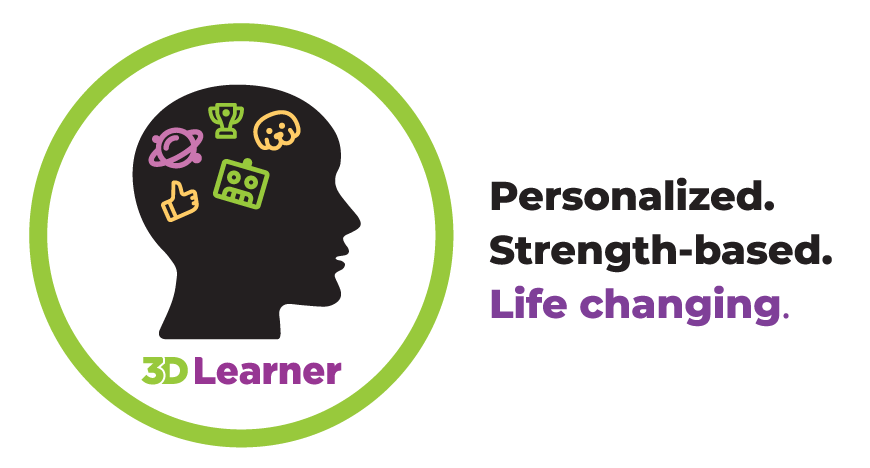
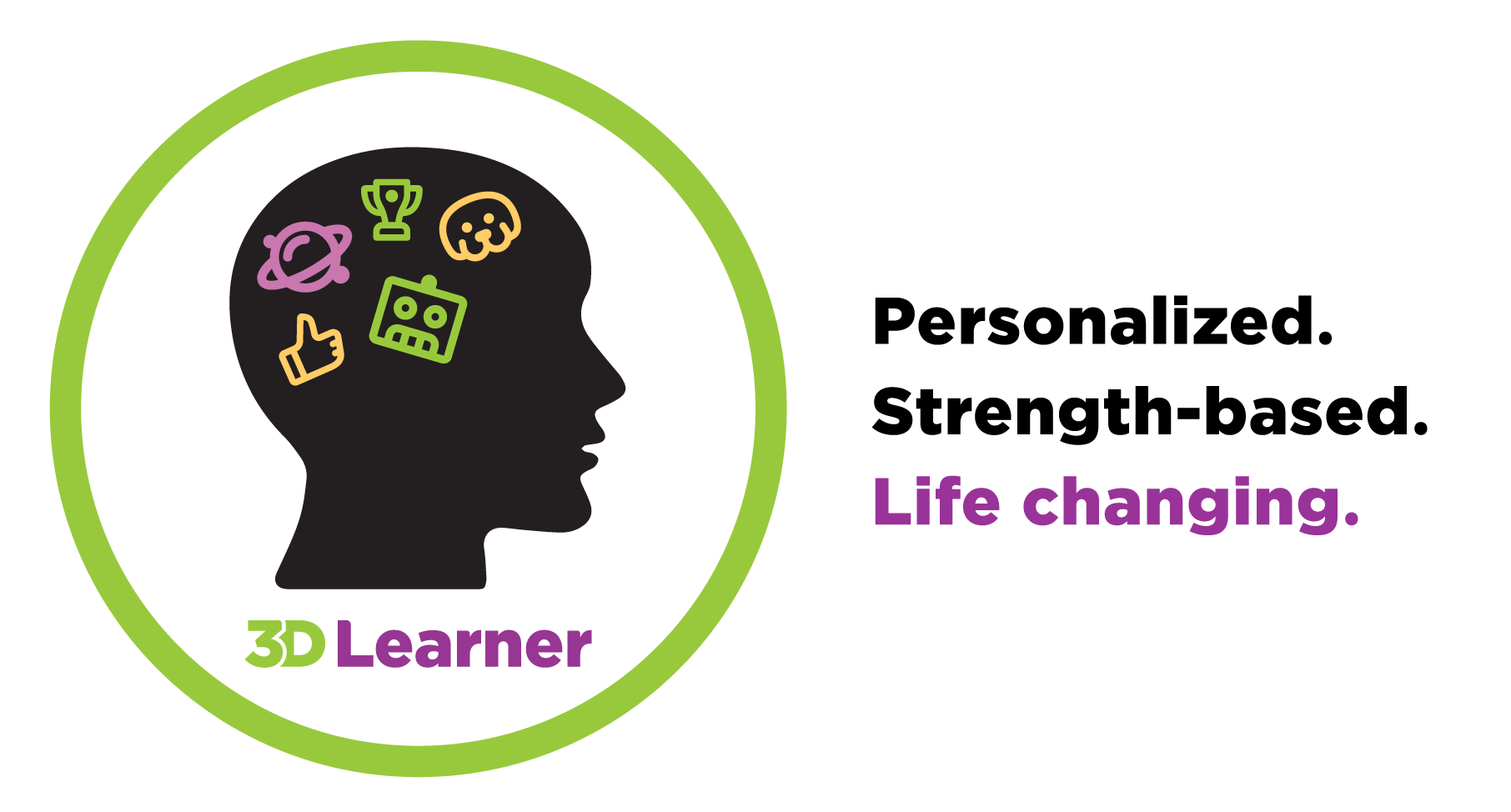






Recent Comments